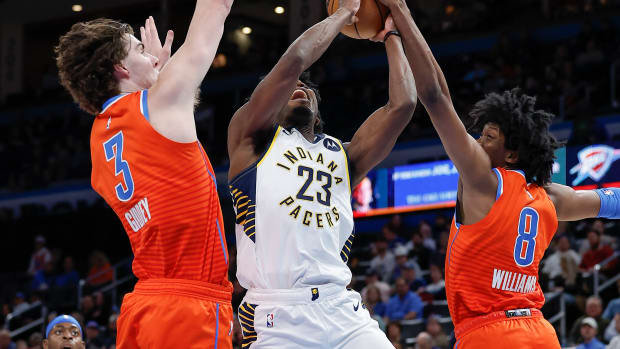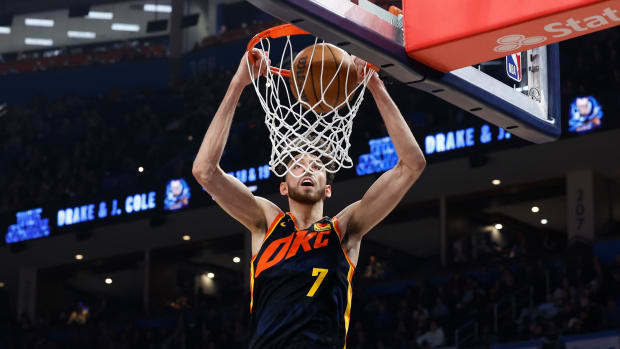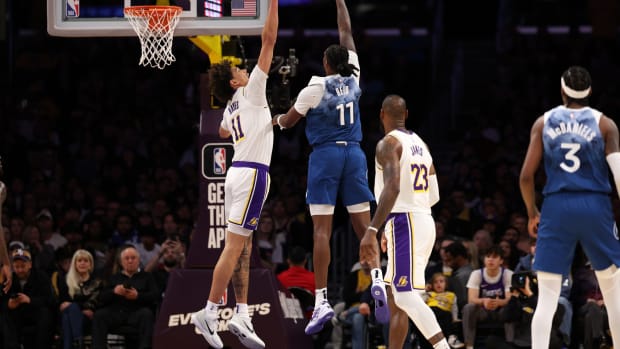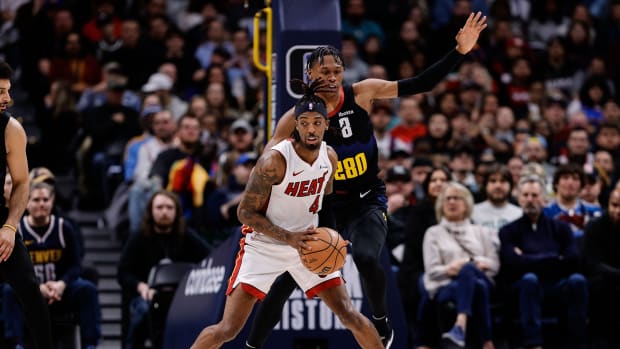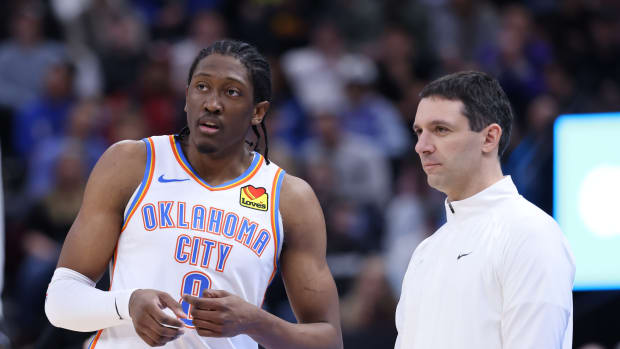Biggest Takeaways: The NBA's New CBA Deal
In an anticipated, but nonetheless critical development in professional basketball, the NBA and NBPA on Wednesday tentatively agreed on a new seven-year collective bargaining agreement.
Although both sides still need to ratify the agreement, agreement is widely expected. In light of the need for ratification, the two sides have mutually agreed to postpone the Dec. 15, 2016 deadline for either side to opt out of the current CBA until Jan. 13, 2017. If either side were to opt out, the current CBA would be set to expire on June 30, 2017 and a lockout would almost certainly begin on July 1, 2017. Instead, once ratified, the new seven-year CBA will begin in the 2017-18 season and run through the 2023-24 season, with either side able to invoke an opt out clause in 2022.
With a tentative deal in place, here's a look at the biggest takeaways from the new CBA deal:
Adam Silver and Michele Roberts learned from the mistakes of their predecessors
The new CBA is the first negotiated by NBA commissioner Adam Silver and NBPA executive director Michele Roberts. Both leaders deserve credit for striking a deal before a labor dispute—and accompanying antitrust litigation—arose. Consider the different result of the last labor negotiation between the NBA and NBPA. With David Stern and Billy Hunter in charge, respectively, in 2011 there were plenty of lowlights:
• After months of poor communication, the NBA locked out the players on July 1, 2011. A lockout meant that players were not paid their salaries. Players were also denied other employment benefits, such as team-funded healthcare, and access to team facilities. The lockout would last 161 days, the second-longest lockout in NBA history.
• The NBPA disclaimed interest, a maneuver under labor law where the NBPA declared that it no longer represents its players and thus did not bargain on their behalf.
• Carmelo Anthony and 13 other players filed a federal antitrust lawsuit against the NBA, arguing that the lockout violated Section I of the Sherman Antitrust Act.
• The NBA canceled 240 games, leading to abbreviated 2011-12 season where each team played 66 games instead of 82. Arena workers, security staff and restaurants and bars dependent on business from NBA games all lost substantial revenue.
• A deal on a new CBA was finally reached in December 2011 and it was a deal that could have—and should have—been reached before the lockout began.
This time around? No lockout, no disclaimer of interest, no lawsuit, no regrets—just a deal, after months of continuous and productive negotiation sessions.
No need to change a good thing
While all of the specifics of the new CBA have not been made public, sources familiar with the negotiations have shared details with The Crossover. The details reaffirm an overarching point: both sides emerge as winners. In that same vein, the new CBA is more about targeted tweaks than fundamental shifts. Both sides recognize that economic prosperity in the NBA already exists for owners and players, and it would be unwise to radically alter the current state of affairs. The league’s nine-year, $24 billion TV deal with ESPN and Turner Sports, along with lucrative sponsorship deals, already provide for a healthy economic landscape. Neither side wanted to jeopardize that with a labor dispute.
NBA First-Quarter Awards: An MVP Race For The Ages And More
Likewise, although NBA owners and players may disagree about whether certain teams in smaller markets are losing money due to smaller regional TV deals, both sides surely concur that most NBA franchises are doing quite well and would net enormous sums of money should they be sold—some reports suggest that as many as 13 NBA teams are now worth more than $1 billion.
Further, of all the major U.S. pro sports leagues, the NBA is best positioned to become the first truly global league. It has a massive and growing international fan base and an ability to generate more and revenue every year. As explained below, the new CBA should accelerate those positive trends.
Basketball Related Income: Everyone’s about to get rich(er)
The topic that was most likely to trigger a lockout in 2017 was how players and owners were going to divide and define Basketball Related Income, better known as “BRI.” This is a term that captures most types of revenue generated by NBA games, and BRI is essentially the pool of NBA money that is shared by owners and players. BRI includes sizable percentages of revenue from apparel sales, arena signage, NBA television broadcasts and many other NBA products and services that lead to incoming dollars. Depending on various factors, NBA players receive between 49% and 51% of BRI. This percentage will not change in the new CBA. Preserving that percentage is considered a success for Silver and the owners, who insisted upon not conceding on BRI.
Players, however, are expected to receive much more BRI in the new CBA. There will be an increasing influx of revenue into the game through broadcast deals that are climbing quickly in value. In addition, the NBA and NBPA have reconfigured the definition of the categories of revenue that are classified as BRI. So while the distribution of BRI will remain constant, the pool of BRI will grow. In fact, one source familiar with the new CBA tells The Crossover that while NBA players in 2011 received 57% of BRI through the CBA, players will net at least $1.5 billion more in BRI in the first year of the new CBA. This, again, is because of more incoming revenue. For Roberts and the players, a more prosperous BRI is a decisive victory.
Salaries will climb dramatically
According to those familiar with the new CBA, key categories of player salaries will experience healthy rises ranging from approximately 45% to 50%.
For instance, take the NBA’s minimum salary. There are actually 11 versions of the NBA’s minimum salary, as they range based on number of years of NBA experience. The lowest minimum salary for the 2016-17 season is $543,471, which is assigned for rookies, while the highest is $1,551,659, which goes to veteran players who have 10 or more years of NBA experience.
Taking the current lowest NBA minimum salary, $543,471, it is obviously a lucrative salary by any reasonable measure. In fact, it is in the top 99.5% income percentile bracket in the United States. Now consider that the lowest NBA minimum salary will rise substantially in the new CBA: there will an approximate 45% increase in minimum salaries across the board. This means that a player who would have earned $543,471 on a minimum contract under the old CBA will get a bump to about $788,033—and a bump into the top 99.9% income percentile bracket in the United States.
Similar jumps are expected in the NBA’s rookie wage scale and mid-level exceptions. In addition, the new CBA will feature a “designated veteran player exception” that will permit NBA teams to re-sign their star players for longer contracts and at higher pay rates.
Not surprisingly, then, the average NBA salary, which in the 2015-16 season is reportedly $5.3 million, will climb steeply under the new CBA. The average player salary in the 2017-18 season is projected to be $8.5 million. By 2020-21, the average NBA salary will reach about $10 million.
Larger rosters and two-way players
Beginning in the 2017-18 NBA season, rosters will grow by at least one player and possibly two. With 30 NBA teams, a roster increase by at least one will mean at least 30 new jobs. For players fighting for end-of-bench jobs, an extra slot on each team could prolong NBA careers for years. Those players will also be playing in the NBA rather than a pro league in another country.
The new CBA will also allow teams to negotiate “two-way contracts,” which will be contracts where a player is paid a different rate depending on whether he is assigned to an NBA team or that NBA team’s D-League affiliate. The math of the two-way contracts remains to be seen. As of now, there is a massive gulf between the lowest category of NBA minimum salary ($543,471) and the highest salary in the D-League (a pay rate based on an annual salary of $26,000). If D-League salaries are to remain very low and if two-way contracts won’t offer higher-than-normal D-League pay, some players who are offered two-way contracts by NBA teams will be inclined to pursue more lucrative contracts abroad, particularly if they conclude that they would likely spend much of their two-way contract in the D-League.
Less taxing schedule for players
In recent years, a number of NBA teams, most notably the Spurs, have been criticized for resting players towards the end of long road trips, especially those trips featuring “back-to-back” games. The alternative is that coaches play fatigued players and those players struggle to provide the quality of play fans expect. Tired players are also more prone to injuries. To address this tension, the new CBA will cut back on back-to-back games and assign more days off between games. The regular season schedule will be extended by seven days to create this space.
Vastly improved pension and health care plans for retired players
One of the challenges in any CBA negotiation in pro sports is that current players negotiate not only on behalf of themselves, but also on behalf of retired and future players. In some cases, the interests of those two other groups are mostly ignored. Not so for retired NBA players. NBA pensions are expected to rise by nearly 50% for former players who begin to receive pension payments at age 50, and there will be corresponding increases for retired players who elect to begin payments at older ages.
Crowning The King: LeBron James is Sports Illustrated's 2016 Sportsperson of the Year
This is a wise policy change by the NBA and NBPA. Both organizations recognize that the transition from earning lucrative salaries as an NBA player to far more modest salaries as a former NBA player is jarring. For many players, the transition occurs much earlier in life than they expected or hoped. The two organizations also know that retired players who are now in their 60s or older were instrumental to the league’s current success, yet played in eras where NBA salaries were dramatically lower. Bumping their pensions is one way of recognizing their instrumental role in making current NBA salaries so high.
A similar reasoning has led to a new retiree health program for NBA players who played at least three years in the league. Beginning on January 1, 2017, these players will be guaranteed health care for life. While retired NBA players are often in better neurocognitive health than retired players from the NFL, NHL and other sports with frequent head trauma, retired NBA players still suffer from the consequences of ankle, knee and other injuries to the extremities. Their health bills can climb quite high as they get older. The NBA and NBPA will collaboratively fund this new health program.
Revised health policies for current players
The new CBA will make important adjustments to the relationship between players and teams in health care choices and the delivery of that care. For instance, the two sides have agreed to formalize a program for players to receive a second opinion on a health care matter, and will use medical specialists who have been approved by both sides.
The two sides also recognize privacy concerns with wearable technology and use of accompanying data. They have agreed to form an advisory committee to study the issue and offer recommendations that would be considered by both the NBA and NBPA.
Mental health will also receive long-needed attention in the new CBA. Uncertainties over mental policy played a disruptive role in the disagreement between Royce White, who suffers from general anxiety disorder, and the NBA over the terms of his employment (expect a future The Crossover story on White’s experience and related legal issues). The new CBA is expected to feature extensive procedures that will assist players in coping with mental health challenges. It appears that both owners and players realize that mental health issues can be as, if not more, debilitating to one’s basketball career as are so called “physical” injuries.
Revised policies for domestic violence, sexual assault and child abuse
Unfortunately, like all professional sports leagues, the NBA has been faced with players accused of, and in some cases found guilty of, committing sexual violence. This topic attracted particular notice in 2014, when the NBA suspended Jeffrey Taylor after he pleaded guilty to a misdemeanor domestic violence charge. It has remained a priority for both the league and players’ association.
Instead of imposing automatic suspensions like those used in the NFL (which, as shown with Giants kicker Josh Brown, are not always automatically imposed), the NBA, in conjunction with the NBPA, recognize that each domestic violence incident varies considerably in its set of facts and context. Each, therefore, should be treated as an individual matter deserving an individual prescription. To help advance that objective, the new CBA will detail a comprehensive set of policies for investigations, discipline and appeals. A wide-range of preventive resources, including a confidential hotline for players and their families, will also be offered.
One-and-done rule to remain—for now
The NBA’s current eligibility rule is found in Article X of the CBA. Under it, U.S. players are not eligible for the draft until they are 19 years old (plus one NBA season must have elapsed from when those players graduated high school or would have graduated high school). International players, who can turn pro in other basketball leagues as young as age 14 or 15, must also be 19 years old. Unlike U.S. players, however, international players do not have the added hurdle of having to wait until one season elapses after high school.
Sources familiar with the CBA negotiations tell The Crossover that the eligibility rule will not change, but that the NBA and NBPA have agreed to study it further and possibly implement changes at a later date. Keep in mind, the NBA and NBPA could mutually agree to amend a term in the CBA at any time—they do not need to wait until the next CBA in 2024 to do so. Thus the eligibility rule could be modified as soon as for the 2018 NBA draft.
The continued existence of what has become derisively labeled the “one-and-done rule"—in recognition of players who attend college for a year (and, in reality, take classes for merely the fall semester and then drop out mid-way through the spring semester) and then jump to the NBA—is something of a surprise. Shortly after he became NBA commissioner in February 2014, Silver pledged that raising the eligibility rule was one of his top priorities. NBA teams and their owners would prefer that young players either play in college or in other professional basketball leagues. This would allow NBA general managers more time to evaluate them. Plus, these players would physically develop and obtain more polished basketball skills at the financial expense of other entities.
What Will The NBA Look Like In 2020?
Working in the opposite direction are those who contend that players good enough to enter the NBA out of high school ought to be able to enter the NBA at that time. Players could make this jump between the 1976 and 2005 NBA drafts. LeBron James, Kevin Garnett, Kobe Bryant, Tracy McGrady, Tyson Chandler and Al Jefferson were among those who did and succeeded. Going straight from high school to the NBA enabled these players to become free agents much earlier in their careers than their college-educated peers. They were thus positioned to sign multiple large NBA contracts during their NBA careers before their skills declined due to age in their mid to late 30s (Jefferson, of course, is still likely in his peak years at age 31). Further, of the major U.S. professional sports leagues, only the NBA, WNBA and NFL require that players satisfy a period of time after high school before they are eligible to enter those leagues. Baseball, the NHL, pro tennis, pro golf, pro soccer, NASCAR—not to mention actors and musicians—are not obligated to meet such a requirement. So why should NBA players be treated differently?
For the time being, do not expect a change in the NBA’s eligibility rule. If a change occurs, it stands to reason that a compromise arrangement might be reached. One such compromise would be an eligibility rule akin to baseball, where players can turn pro out of high school but if they enroll in a four-year college, they must stay in the college for three years. Perhaps instead of three years, the NBA might expect a two-year commitment.
Such an eligibility rule, however, would be worrisome for some college basketball programs. After all, players who are not ready for the NBA out of high school might be more inclined to earn six figures playing for a basketball team located overseas rather than committing to a U.S. college for two or three years while waiting out the NBA’s eligibility rule. Then again, colleges and the NCAA could make the necessary adjustments: if colleges want to compete against foreign pro basketball teams for premier basketball talent, perhaps amateurism rules should be adjusted to let them do so.
Michael McCann, SI's legal analyst, provides legal and business analysis for The Crossover. He is also an attorney and the founding director of the Sports and Entertainment Law Institute at the University of New Hampshire School of Law.


































